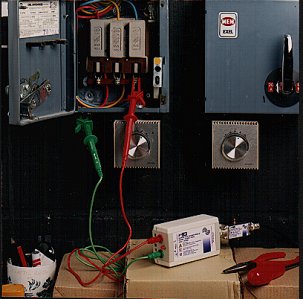A common 'route' by which noise is transmitted from one product to other 'victim' products is via the mains supply. Therefore a fundamental requirement specified by the EMC regulations is to measure the level of this noise and to ensure that it is within acceptable limits. There are also limits regarding noise conducted down other long cables, such as telecom connections. CISPR16 specifies the appropriate 'transducer' to couple the RF from the cable to the analyser. These 'transducers' are either a LISN (Line Impedance Stabilisation Network), voltage probe or CDN.
LISNs provide a stable impedance of 50ohm for RF frequencies up to 30MHz, but require the load current to pass though them. Laplace provides a range of LISNs for single and three phase supplies, up to 100A per phase. The Voltage Probe simply clips on to the line to be measured, so has no current limit, but accuracy is impaired because the impedance is not stabilised.
Both are specified in the EMC standards such as CISPR16, but the LISN is always the preferred choice. The voltage probe is only used when a LISN is not appropriate, for example when the load current is too high to accommodate with a LISN, or when it is not possible to break into the power line to connect the LISN.

Use of a Pre-Selector is recommended for any EUT that may produce significant levels of broadband emissions. These are created by impulsive sources such as phase angle controllers, and electronic switching power supplies as is frequently fitted to many modern products.
The Voltage Probe requirement is covered by our PLIP (Power LIne INterference Probe). This fully meets the requirements of CISPR16, but has additional features:
- Fully galvanic isolation between input and output (>1kV), for the safety of operator and analyser!
- Shrouded safety clips for attachment to the line to be measured.
- Filtered frequency response matched to Band A and B.
- Current limiting on the output.
- Visual indication of high voltage input.

